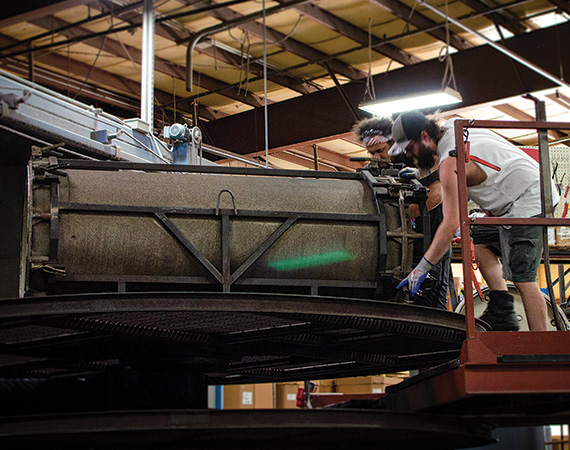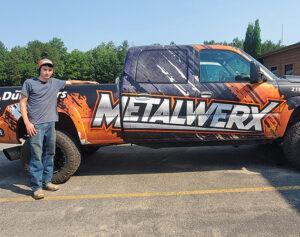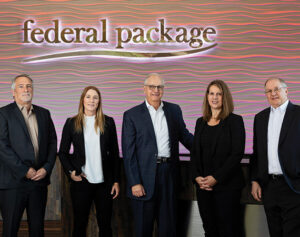Throughout 2017, Shawn Hunstad struggled to attract a sufficient workforce to process the extraordinary growth in sales that threatened to overwhelm the production capabilities at Stern Companies, Inc., his Baxter-based manufacturer and distributor of rubber and plastic products.
Rather than cannibalize the existing workforce in the greater Brainerd region, he discerned that a stable solution might be to expand elsewhere. His instinct proved prescient when he learned of the empty facility of Premier Plastics in Hoyt Lakes. A Wisconsin company had purchased Premier a year earlier before relocating its manufacturing operations to Wisconsin. Finding the space gave Hunstad room to expand, but finding people comprised the prize. Many experienced plastic thermoformers didn’t make the move to Wisconsin. The plant and the people provided Stern with exactly the capabilities Hunstad needed to fulfill a contract with Brunswick New York Mills — the manufacturer of Lund and Crestliner boats.
Hunstad acquired the plant with financial assistance from the Minnesota Iron Range Resources and Rehabilitation Board (IRRRB).
For Hunstad, the number-one priority was growing the company’s workforce without compromising the Brainerd and Baxter operations.
“We looked at Hoyt Lakes as far enough away from this region to be able to tap a different employee pool,” he recalls.
The 35,000-square-foot Hoyt Lakes facility today runs two shifts of 20 total staff on rotational molding and thermoforming of boat consoles for that aforementioned Brunswick contract, BOSS Snowplow salt-spreading hoppers for ATVs and pickups, sleds for Eskimo-brand fish houses, and outdoor food oil tanks for Restaurant Technologies.
But while the Hoyt Lakes venture offered an expanded workforce and new manufacturing processes for in-house production — which was reaching over 50% of their sales for a company that began as a brokerage — new business continued coming in to Stern every month. Even with the increased capacity, eventually the company would need to find another creative way to avoid turning down work.
The Hoyt Lakes solution to Stern’s workforce challenges is just one insight into how Hunstad has used entrepreneurial vision, agility, and self-confidence to create a diverse, $27 million, 135-employee company that occupies a quarter-million square feet of manufacturing space in four facilities across Minnesota.
History of adaptation
Stern’s path to success hews closely to the intuitive vision of Hunstad. After receiving a degree in business administration from the University of North Dakota in 1988, he knew his future began in Brainerd. He moved there straight out of college, and after a few years selling copy machines, found his calling in a traveling sales job with the Stern Rubber Company. The company provided custom-molded rubber parts via compression, transfer, or injection molding from a facility in Staples. In 1992, it was headed toward a growth spurt. Hunstad would play his part, but it was a winding road from here to there that would test his resolve and the company’s ability to adapt.
Initially a road warrior combing the state for clients, he left the road and serviced his ever-expanding customer list via telephone. He split the national list with John Ace, a more experienced salesman who became Hunstad’s mentor. Living close by, the two commuted to and from the office every day, a time Hunstad used as in-car training.
“I can’t put enough emphasis on how important that was for me,” Hunstad says. “Being able to talk to John on the way to work for that half hour, and then the same on the way home, was beneficial for me.”
In 1995, the company’s biggest client, Polaris, was facing challenges with its plastic component suppliers and urged Stern to venture beyond rubber manufacturing. The two companies had a good relationship, and Polaris, Hunstad says, believed Stern could provide a better value. The father-and-son ownership of Stern Rubber started a subsidiary company, Stern Industries. Rather than enter manufacturing directly, Stern Industries would function as a brokerage between suppliers and manufacturing clients. Hunstad assumed the lead role within the first year of the two-man company’s history.
Working from a spare room in his Brainerd home, Hunstad says it was a matter of building relationships with vetted suppliers that could meet manufacturing needs on time, every time. In effect, he offered a turn-key solution to manufacturers, and the company grew as customers found how simple it was to work with Stern Industries rather than researching and coordinating with suppliers themselves. A year later, the business model evolved slightly, from a pure brokerage into a model of “buy, hold, supply.”
“The company with that format grew exponentially over the years,” Hunstad says. “The engineers at many of these companies found how easy it was to just go to us. It went crazy.”
In the first year, the two-man sales team brought in about $250,000, Hunstad recalls, and doubled that to $500,000 the next year. One decade later, that number was north of $10 million.
The company grew until a spare room could no longer contain the activity. Hunstad rented a small office suite with room enough for two salesmen and a receptionist. Shortly thereafter, he upgraded to another new facility on Highway 371 that provided some warehouse space. And when that was no longer enough, Hunstad relocated to Stern’s present 11,000-square-foot headquarters in Baxter.
Solution seeking
At Stern Industries’ parent company, Stern Rubber, growth had been swift around 1997 and 1998, expanding to a second facility in Aitkin. A new operation opened in a downtown incubator building before being relocated to the Aitkin industrial park in 2002. Things looked good for both halves of the company until, Hunstad says, the owners made a “colossal” mistake by failing to move some of the labor-intensive rubber manufacturing overseas. National competitors were already making the switch, and Stern Rubber was being priced out of the market.
For his part, Hunstad — who had worked his way into a 50-50 ownership of Stern Industries alongside Terry Stern, the younger co-founder of Stern Rubber — hired a representative in Asia to handle importing for Stern Industries. Stern Industries remained primarily a brokerage between manufacturers and suppliers, now with competitive offshore products as well. Hunstad says it was around 2005 that his side of the business began to eclipse its parent company.
In 2006, Hunstad had his eyes on bringing at least a portion of the manufacturing in house, which today makes up approximately 60% of Stern’s revenue. To him, it was the best way to maintain control over production and ensure good relationships with his manufacturing clients, rather than being entirely beholden to other suppliers. Hunstad bought out a Brainerd-based supplier, Nor-Pac Industries, that provided plastic rotational molding products, such as kayaks, and was looking to transition out of the business. It was an opportunity he couldn’t resist, and it would be the first acquisition of many. Stern bought up the equipment and existing clients without skipping a beat, under the new subsidiary of Stern Assembly, marking their first foray into plastic production.
As Stern Rubber and Stern Industries jockeyed to outsell one another, the owners of both companies (Hunstad and Terry Stern of Stern Industries, and Terry Stern of Stern Rubber) decided to bring the two together as one under the new name of Stern Companies, Inc. Things looked great for the few years prior to the recession, but the economic downturn would be crushing for Hunstad’s half of the business and its brokerage model. The company’s biggest clients, like Polaris, were themselves fighting to weather declining sales of recreational vehicles. The “middleman markup” of working with a brokerage was a cost Polaris wanted to leave behind. Hunstad says he believes the decision proved more costly than those companies anticipated because they lost his team’s expertise and relationships, but the immediate problem was a major revenue gap for Stern Industries.
It could have been a death spiral. In 2009, Hunstad and Terry Stern split the two companies back apart for good. Hunstad says he took control of the plastic operations (Stern Industries, along with Stern Assembly). Terry Stern walked away with the rubber business, including the offshore rubber manufacturing suppliers brought in by Hunstad under the Stern Industries banner.
The recession in ’09 and the resulting split, “righted the ship,” Hunstad says, by exposing flaws in an inadequate way of doing business. Both companies, Stern Rubber and Stern Industries, had leaned too much on a single client to support their businesses, and the recession taught Hunstad never to make that mistake again. For context, in 2008, the combined Stern companies were a $50 million business with one customer, Polaris, accounting for more than 80 percent of revenue. When Polaris had a problem, Stern had a problem. Diversification would have to become the new normal.
Hunstad took his lumps and, along with his team, researched which industries would best complement Stern’s network of suppliers and rotational molding. Furthermore, he decided that if Stern Companies (now and still today the official name of Hunstad’s company) was going to reach a broader audience, it would need to be flexible. More than a decade later, Hunstad says the business — through his sales team’s constant recruiting of new clients in new industries, like agriculture and food services — sees most clients providing 5-10% of the company’s revenue. Polaris, who remains an important partner, is near that lower figure.
Acquisition
The Hoyt Lakes purchase followed the Brainerd buyout, but it wouldn’t be the last. In November 2020, Hunstad visited Maple Plain-based American Custom Rotomolding (ACR) on news that the company would close. He had hoped to scoop up leftover equipment and supplies, but what he found was an ample factory and 25-30 people still on staff who might be brought in to Stern — exactly what the company needed for a third site.
“We bought forklifts, CNC machines, tables, chairs, you name it. Whatever they had in there, we bought,” Hunstad says.
The purchase closed on January 15, 2021, and the doors reopened just three days later. Better yet, Stern Companies also took over a few government defense contracts.
“The growth potential was just too great to pass up,” Hunstad says. “All the pieces had come together, and pursuing it put us in a really good position long term.”
The latest acquisition brought the company’s total workspace up to just shy of a quarter-million square feet across four cities and four facilities, though much of the Maple Plain space (which totals 135,000 square feet) will be leased out until it’s needed. Despite the purchase, the company is still running 25-40 employees short and turning away work. Which leads to the final pieces of the puzzle: Ardell Paulson and a new focus on efficiency.
Integration
If Hunstad had a user’s manual for good business, it might just be Traction, by Gino Wickman. Hunstad says he is a textbook “visionary” entrepreneur in the popular Entrepreneurial Operating System (EOS). Here’s how Wickman describes the visionary mentality:
A Visionary is a person who has lots of ideas, is a strategic thinker, always sees the big picture, has a pulse on your industry, connects the dots, and researches and develops new products and services. The Visionary typically is the founding entrepreneur, operates more on emotion, and has ADD (but not always). This person is great with big relationships, the culture of the organization, and solving big, ugly problems (not the little ones); sees things others can’t; creates and holds the company vision; and is great at closing big deals. Visionaries are the creators of everything.
Hunstad says that definition describes both his strengths and his weaknesses. He’s grown Stern Companies entirely through custom manufacturing — no proprietary products — with daring leaps, sure, but also through positive reputation, client referrals, and even referrals by fellow rotomolders. But there was something the company lacked. Namely, the right person to make it all sing in harmony. Hunstad could find and close big deals, but the minutia behind those deals exposed his blind spot. In EOS terms, his company needed an “integrator.”
Enter Ardell Paulson, who in January was named president of Stern Companies.
A self-described “reformed sales guy,” Paulson spent nine years in banking and managed his own firms for another 14 years. Then, he transitioned to managing the businesses of others, including five years at Premier Plastics prior to the Stern Companies acquisition.
Paulson and Hunstad go back years and met through mutual clients. They first talked about the job last fall, Paulson says, with Hunstad looking for someone to focus on production and improving efficiencies. “I looked at coming here as a great opportunity,” he says, “because they were a very sales-driven organization and were needing more focus on the operational side. That’s what I’ve been doing for the last 20-some years.”
Paulson and Hunstad first created a continuous improvement team, hiring experienced professionals from other firms to bring their knowledge to Stern Companies.
Paulson says internal success is about competing through efficient processes and a well-trained team committed to continuous improvement. Like other change agents, Paulson says he experienced resistance when Stern Companies rolled out its first efficiency recommendations, but that resistance melted away when he could demonstrate how these new techniques pushed out more product in less time and through less effort. Meanwhile, Hunstad says some of the company’s “rock star” operators had already made process improvements through their own deductions, and the continuous improvement team provided them an opportunity for dialogue up and down the ladder.
Paulson describes the continuous improvement process as addicting and infectious and says it’s in Stern’s best interest in an environment still starved for enough workers. Not only do the efficiencies lower production costs, the investment in people and training shows a commitment that encourages loyalty.
“You get enough people thinking the same way and you can change anything,” Paulson says.
“Everybody’s struggling with attracting talent, but if you get retention, that will help you attract. Word of mouth is invaluable. You’ve got to differentiate yourself from the thousands of other options that are out there.”
There’s still work to be done. The nascent continuous improvement team at Stern Companies is in its first few months, but Hunstad, Paulson, and the teams they lead aren’t short on ideas. Hunstad is investigating the viability of robotics and automation in his operation. It’s a unique challenge to rotational molding, where robotic quality control, for example, is more difficult to program. Errors in flashing are easy for a human eye to identify, but a computerized system could require extensive programming to recognize and flag a defect.
But Hunstad’s not put off by the road ahead.
“Over the next two to five years, we’re going to have a significant investment in automation,” he says. He has lofty goals and recognizes the company will need to grow to achieve them. For want of a workforce, automated techniques will be essential to support that growth. Meanwhile, this man with a track record for spotting an opportunity and wrestling it to the ground is ready for the next big chase.
“I still love the thrill of the hunt, so if something pops up, I will be talking about it,” he says. “Ardell will have to talk me off the cliff.”
Hunstad’s two sons also work for the company he’s helped build, and he hopes the business will continue on through the generations being trained today. Hardwired into his nature though it may be, he recognizes that some day he’ll have to step back and step down, leaving others to take the lead. For now, he’ll trust Paulson and the team he’s surrounded by to keep his dreaming grounded in reality so that the company can get the most from every big idea.
…
Featured story in the Fall 2021 issue of Enterprise Minnesota magazine.


